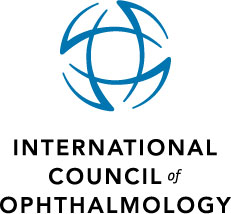Patient: 30 years of age, female, BCVA 0.3 at OD, 0.8 at OS, IOP 15/16 mmHg, nystagmus, microstrabism with amblyopia at OD.
Ocular Medical History: ocular hypertension, trabeculotomy at OD & OS 10 years ago.
General medical History: empty
Main Complaint: decreased vision at OD.
Methods: Colour image, OCT.
Findings:
Anterior segment colour image of OS: Schwalbe‘s ring is seen as a central thickening and displacement of Schwalbe‘s line (arrows), visible with the slitlamp as an irregular white line just concentric to the limbus. At 3h the prominent Schwalbe‘s ring shows an attached iris strand (*)
Optic nerve head colour image of OS: no cupping, pale rim.
OCT of OS: regular retinal nerve fiber thickness.
Ww-Perimetry: Focal scotoma at OD with mean defect of 3.1 dB, no scotoma at OS.
Discussion:
Mesodermal abnormalities of the anterior segment include Axenfeld‘s anomaly and Rieger‘s anomaly. Axenfeld's anomaly shows a posterior embryotoxon. Posterior embryotoxon is a prominent Schwalbe's line that may be a partial or complete bilateral ring and is usually visible on gross external examination. It is an indication of either Axenfeld's anomaly/syndrome or Rieger's anomaly/syndrome, both of which are anterior chamber syndromes that put patients at risk for glaucoma.
Literature:
(1) Nauman GOH. Pathologie des Auges. Springer Verlag 1997
 | Axenfeld's Anomaly with Attached Iris Strand (OS, Colour Image Anterior Segment) |
 | Axenfeld's Anomaly with Attached Iris Strand (OS, Mosaic, Anterior Segment Colour Images) |
 | Axenfeld's Anomaly with Attached Iris Strand (OS, Colour Image Anterior Segment) |
 | Axenfeld's Anomaly with Attached Iris Strand (OS, Colour Image Anterior Segment) |
 | Focal Scotoma in Axenfeld's Anomaly (OD, W-W-Perimetry) |
 | Regular Optic Nerve Head in Axenfeld's Anomaly with Attached Iris Strand (OD, Colour Image Optic Nerve Head) |
 | Regular Retinal Nerve Fiber Thickness in Axenfeld's Anomaly (OD, OCT Circular-Scan) |
 | Regular Retinal Nerve Fiber Thickness in Axenfeld's Anomaly (OS, OCT Circular-Scan) |
 | Regular Visual Field in Axenfeld's Anomaly (OS, W-W-Perimetry) |
-------------------------- --------------------------
-------------------------- --------------------------
-------------------------- --------------------------
-------------------------- --------------------------
-------------------------- --------------------------
-------------------------- --------------------------





